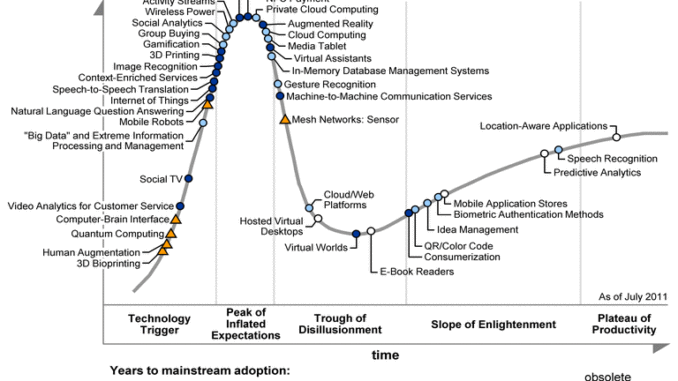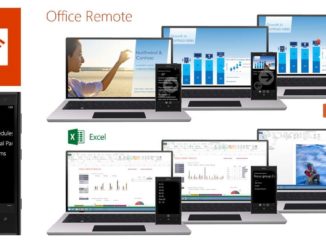
Alle Jahre wieder im August veröffentlicht Gartner seinen Hype Cycle, der jedes Mal intensiv diskutiert wird. Zum Vergrößern bitte drauf klicken.
Hier noch die Erläuterungen aus der Pressemeldung von Gartner:
The „Hype Cycle for Emerging Technologies“ report is the longest-running annual Hype Cycle, providing a cross-industry perspective on the technologies and trends that IT managers should consider in developing emerging-technology portfolios (see Figure 1).
„Hype Cycle for Emerging Technologies“ targets strategic planning, innovation and emerging technology professionals by highlighting a set of technologies that will have broad-ranging impact across the business,“ said Jackie Fenn, vice president and Gartner fellow. „It is the broadest aggregate Gartner Hype Cycle, featuring technologies that are the focus of attention because of particularly high levels of hype, or those that may not be broadly acknowledged but that Gartner believes have the potential for significant impact.“
„Themes from this year’s Emerging Technologies Hype Cycle include ongoing interest and activity in social media, cloud computing and mobile,“ Ms. Fenn said. „On the social media side, social analytics, activity streams and a new entry for group buying are close to the peak, showing that the era of sky-high valuations for Web 2.0 startups is not yet over. Private cloud computing has taken over from more-general cloud computing at the top of the peak, while cloud/Web platforms have fallen toward the Trough of Disillusionment since 2010. Mobile technologies continue to be part of most of our clients‘ short- and long-range plans and are present on this Hype Cycle in the form of media tablets, NFC payments, quick response (QR)/color codes, mobile application stores and location-aware applications.“
Transformational technologies that will hit the mainstream in less than five years include highly visible areas, such as media tablets and cloud computing, as well as some that are more IT-specific, such as in-memory database management systems, big data, and extreme information processing and management. In the long term, beyond the five-year horizon, 3D printing, context-enriched services, the “Internet of Things” (called the „real-world Web“ in earlier Gartner research), Internet TV and natural language question answering will be major technology forces. Looking more than 10 years out, 3D bioprinting, human augmentation, mobile robots and quantum computing will also drive transformational change in the potential of IT.
Many of the technologies featured on this Hype Cycle contribute to the four themes featured in Gartner’s recent report on top technology trends „Technology Trends That Matter“:
The connected world: Advances in embedded sensors, processing and wireless connectivity are bringing the power of the digital world to objects and places in the physical world. This is a slow-moving area, but one that is now accelerating with the growing pervasiveness of low-cost, embedded sensors and cameras. Relevant entries on this year’s Hype Cycle include the broad trend referred to as the Internet of Things; identification technologies, such as NFC payments (which will lead to broader use of NFC for other applications); QR/color code and image recognition; application layers, such as augmented reality, context-enriched services and location-aware applications; and communication technologies, such as machine-to-machine communication services and sensor mesh networks. Although this area will take at least another decade to unfold fully, many interesting and profitable opportunities will arise along the way.
Interface trends: User interfaces are another slow-moving area with significant recent activity. Speech recognition was on the original 1995 Hype Cycle and has still not reached maturity, and computer-brain interfaces will evolve for at least another 10 years before moving out of research and niche status. However, a new entry for natural language question answering recognizes the impressive and highly visible achievement of IBM’s Watson computer in winning TV’s Jeopardy! general knowledge quiz against champion human opponents. Gesture recognition has also been launched into the mainstream through Microsoft’s Kinect gaming systems, which is now being hacked by third parties to create a range of application interfaces. Other areas continue to progress more slowly, including speech-to-speech translation, augmented reality and virtual assistants, while virtual worlds remain entrenched in the trough after peaking in 2007.
Analytical advances: Supporting the storage and manipulation of raw data to derive greater value and insight, these technologies continue to grow in capability and applicability. Predictive analytics is approaching maturity, but researchers and developers continue to apply and improve the core techniques for new data sources. Image recognition is driving new capabilities in search, retail and social media, and also contributes to advances in other areas, such as augmented reality and video analytics, for customer service. Social analytics continues to take advantage of new sources and types of social information. Computational advances, such as in-memory database management systems and big data, take the scope and scale to new levels.
New digital frontiers: Crossing the traditional boundaries of IT, new capabilities are reaching levels of performance and pricing that will fundamentally reshape processes and even industries. Examples on this year’s Hype Cycle include 3D printing and bioprinting (of human tissue), and mobile robots.
„Many Gartner clients use Hype Cycles as part of their technology-planning process, often drawing from multiple Hype Cycles, augmented with industry- or company-specific topics to create their own Hype Cycles and Priority Matrices,“ said Ms. Fenn. „Technology providers use Hype Cycles as a way to understand the likely market reaction to their products and services based on the adopter community’s expectations and attitudes. Investors watch for technologies that are on the rise in a Hype Cycle to try to catch them before the Peak of Inflated Expectations or at the beginning of the Slope of Enlightenment before they move into mainstream adoption.“





die NFC Position versteh ich nicht